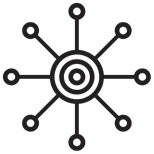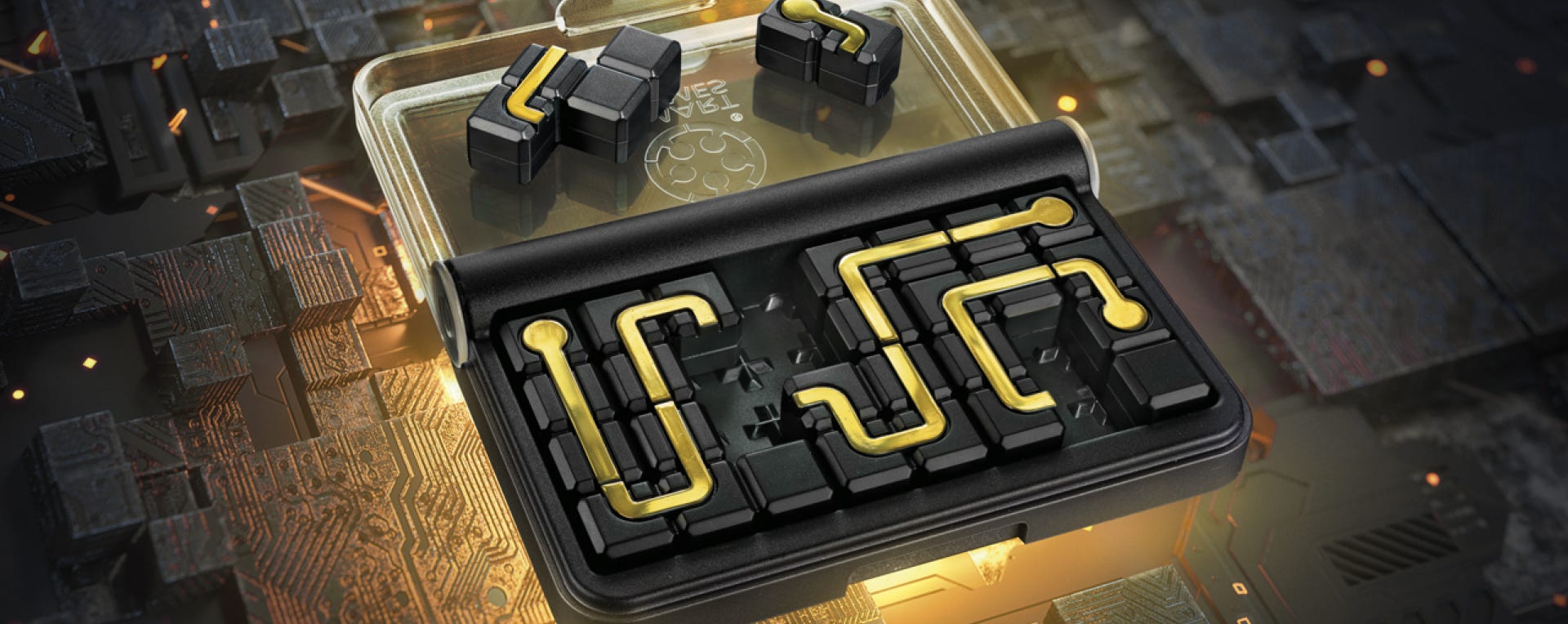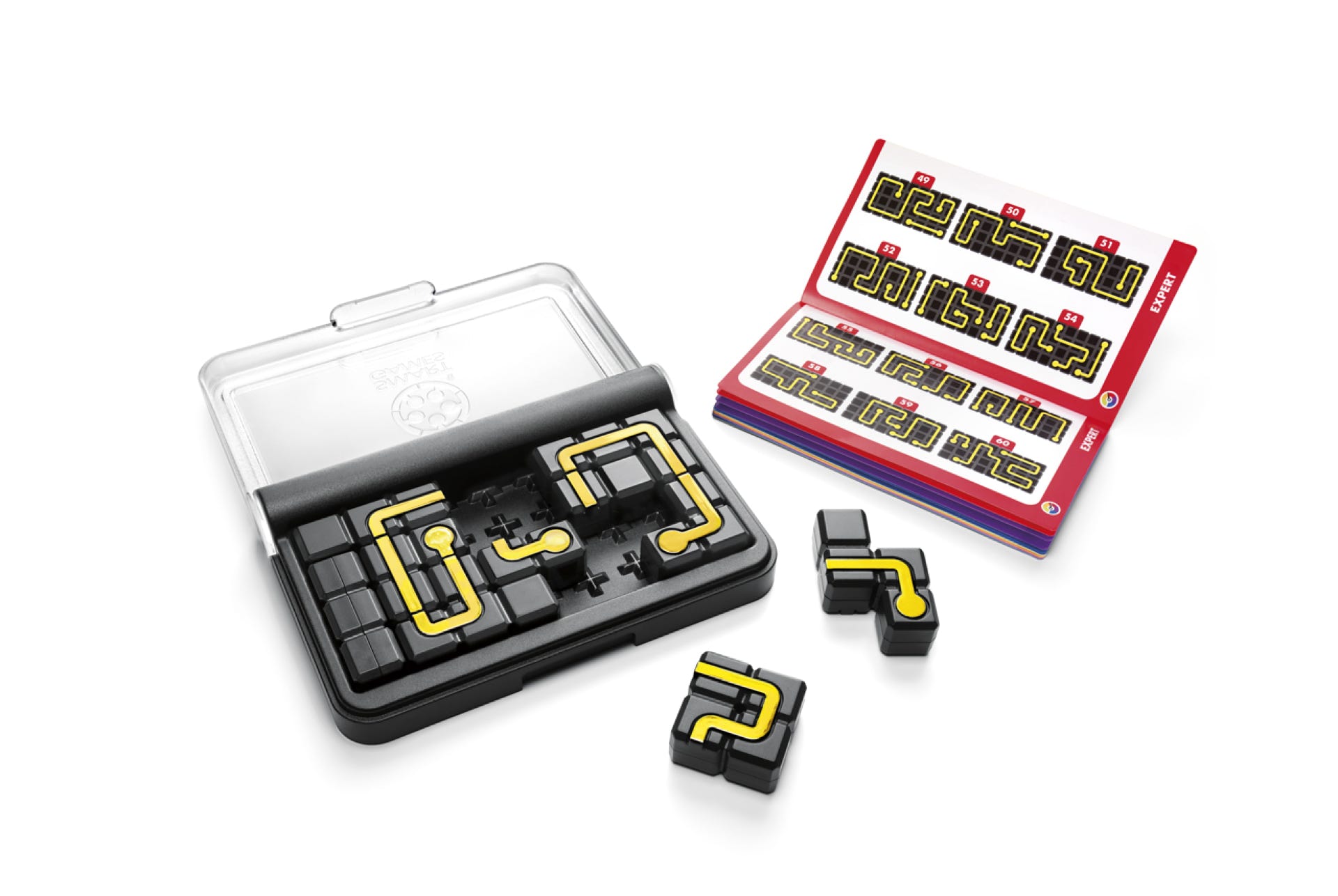
IQ-Circuit

The product development of IQ-Circuit (for SmartGames)
Raf Peeters, March 2021
This IQ-puzzle I designed for SmartGames is a “golden” edition. It’s the 10th IQ-puzzle I developed. And it’s about 10 years ago I started creating the first one (IQ-Twist). But this game is also special for another reason. Although all games in this IQ subbrand are 2D packing problems, this is the first which is also a connection game. And to differentiate this game even more, we made it black with the paths in gold.
CAN YOU CONNECT THE DOTS?
From the start the idea was to do something with connections, like Anaconda. The inspiration was clearly PCB’s (printed circuit boards) you typically find inside a computer. The problem to make a connection game work on such a small game board, is that it is very restricted. Each puzzle piece must fit on the game board AND should also have the right connections to adjacent puzzle pieces. But at the same time dead ends or paths that are not connected to a dot are not allowed.
So it took a lot of time to find a set of puzzle piece that made this possible. To allow for enough different packings, this game includes 10 rather simple puzzle pieces, made of only 2, 3 or 4 cubes. Most pieces are double sided, so they have different options on top and bottom side. But the 4 rectangular piece can also be used on their sides, and thus have a third option. These sides are empty, so they are ideal to fill up part of the game board where you don’t need any connections. This resulted in 179 different packings, which was nearly enough to create 120 challenges because some packings look very similar.
The next hurdle was to design the pieces (together with my colleague Leighton) so that they could be mass produced for an affordable cost. We tried different options with solid pieces, pieces with inserts or overmolding, but settled with the simplest solution. In the final design, each piece is made of two parts that are ultra-sonic welded together and are printed on both sides using gold foil and heat transfer.
To avoid that the gold print would be scratched too easily, the surface of the path is slightly recessed compared to the rest of the puzzle piece. And when you place the pieces on the game board, they are only supported in the corners, so the gold print never touches the bottom of the grid. Every IQ-puzzle so far has a packaging in a different color, but with 9 different games, the color options were limited to white, black, silver or brown. We choose black which looks great in combination with the gold foil we also used on the logo of the packaging. It give everything a more premium look and looks a bit less childish than the multi-colored other IQ games.
The object of the game is to place all puzzle pieces on the game board AND to connect the dots. Challenges can have 2, 4 or 6 dots, so you need to create 1, 2 or 3 separate paths. Paths never cross each other or connect more then 2 dots. Depending on the level you get more or less information:
- STARTER: The shape of all paths and the shape and position of some puzzle pieces is shown.
- JUNIOR: The position and shape of all puzzle pieces is shown, but not the shape of the path(s). Attention, some puzzle pieces have the same shape!
- EXPERT: The shape of all paths is shown.
- MASTER: The shape and position of some puzzle pieces with dots is shown.
- WIZARD: Only the position of the dots is shown.
At first sight, the Junior challenges look harder than the Expert challenges, because the latter show you complete paths. But the Junior challenges are easier (as it should) because they give you hints about the shape of each puzzle piece (white contours) . This is a much more powerful hint than only showing the resulting paths.
IQ-Circuit will be available in 2021, but not yet in all countries. And in some regions it will exclusively be available from select resellers.

Starter example of a challenge (left) and solution (right)

Junior example of a challenge (left) and solution (right)

Expert example of a challenge (left) and solution (right)

GAME RULES IQ-CIRCUIT
1) Select a challenge. Each challenge shows 2, 4 or 6 dots.
2) The object of the game is to connect all dots with a path:
A) All puzzle pieces must be placed on the game board.
B) Most puzzle pieces are double sided. The rectangular puzzle pieces can also be placed showing a blank side (without a path). Therefor, these pieces have 3 possible options.
C) Each path starts and ends at a dot. Unconnected path pieces are not allowed.
D) Each challenge shows ALL dots you need for that challenge.
• If a challenge shows 2 dots, you need to create 1 connecting path.
• If a challenge shows 4 dots, you need 2 separate paths.
• If a challenge shows 6 dots you need 3 paths.
You are not allowed to add dots that are not shown in the challenge!
E) On top of the dots each level shows extra hints, such as the position of puzzle pieces or the shape of the path(s).
F) When the path is not shown in the challenge and there are more than 2 dots, any dot can (theoretically) be connected with any other dot.
3) There is only 1 solution, which can be found at the end of the challenge booklet.
Website ©2021 Raf Peeters
Products and images: © Smart